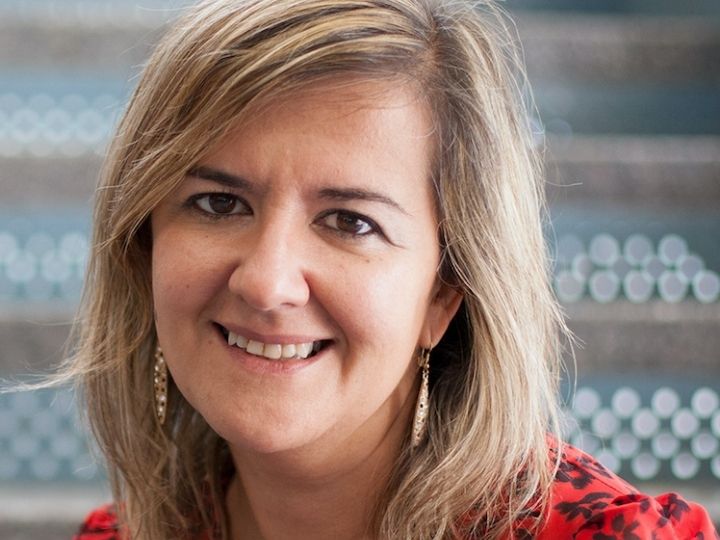This image taken by the Hubble Space Telescope shows the open star cluster NGC 330, which lies about 180,000 light years inside the Small Magellanic Cloud. One of the objectives of the mission was to determine how big the stars can be before they are doomed to end their lives in cataclysmic supernova blasts. (Photo courtesy of NASA)

Claudia Ratti, associate professor of physics at UH
The universe offers mysteries that intrigue even experts. Among the big questions: What is the nucleus of a neutron star made of? And what happens inside the massive explosion when two neutron stars collide?
“Throughout the universe there are once massive stars that ran out of fuel and collapsed, bringing their protons and neutrons together so tightly that they became neutron stars that are a fraction of their original size. “, associate professor of physics at the University of Houston. Claudia Ratti explained.
With the exception of black holes, they are the densest objects known to astronomers – and are the subject of a five-year collaboration supported by a $ 3.25 million grant from the National Science Foundation (NSF) . The Multi-Messenger Fusion Nuclear Physics (NP3M) project is being carried out by research teams at five US universities.
“The NP3M is a national effort in nuclear physics and astrophysics to probe the properties of hot, dense matter at the heart of neutron stars. This unknown matter reaches extremely high temperatures when two neutron stars collide, â€said Ratti, the UH team’s principal investigator.
The UH team is joined in the hub by researchers from the University of Tennessee-Knoxville (the lead institution of the NP3M collaboration) and teams from Indiana University, Pennsylvania State University and Syracuse University. In addition, 13 senior researchers from other US institutions will contribute, as will scientists from 26 international groups.
The creation of the NP3M hub was sparked by a recent breakthrough that confirmed that neutron stars do indeed collide in an event now called neutron star fusion.
“It’s a very violent event that produces gravitational waves that can be measured,†Ratti said. “The mergers had been suspected for a long time, but there was no real evidence of their existence. Then in 2017, the LIGO / Virgo collaboration observed gravitational waves associated with a fusion of binary neutron stars. Since then, several projects have attempted to interpret LIGO data or create models to define what happens inside collisions.
Gravitational waves are a key player in the physics of messengers. The field of study is so named because it depends on phenomena that signal the presence of something – in this case, a neutron star merger – that cannot be seen with any current technology. The detection of gravitational waves not only won a Nobel Prize, but also gave astrophysicists an additional tool to observe dense matter inside neutron stars.
“The NSF recognizes that this is a very hot topic right now, so they have called for a dedicated and focused hub that shares research among multiple universities. It’s exciting to have the opportunity to have weekly discussions with colleagues at the hub. And I think it’s a unique opportunity for the field to make real progress, â€said Ratti.
Each participating team will work from its home institution and in a defined area of ​​expertise, but frequent meetings and exchanges will allow for a very lively collaboration. “The University of Houston will be in charge of the more theoretical part of the project. We are experts in fundamental and high energy nuclear physics, so we are going to digitally simulate the theory of strong interactions, â€explained Ratti.
The hub will also provide an impressive opportunity for participating postdoctoral researchers to work remotely with top experts from multiple fields while collaborating in person with their mentors at their home university.
“They will not only develop a set of expertise. They will not only be nuclear physicists, for example, they will also learn astrophysics and the detection of gravitational waves. They will therefore have a much more complete experience and set of expertise at the end of the five years of this targeted pole. “
The NP3M project will also have an impact on the community. Software will be developed and deployed to teachers (from 12e up to kindergarten), with special awareness of rural schools.
Ratti identifies with children curious about science, having been curious herself.
“As a child, I had a passion to understand how things work on a small scale, what they look like up close. In high school, I became fascinated with physics because I recognized that it was the only subject that could explain things in the most depth. That’s why I became passionate about it, â€she said.
“I guess the will to see things up close grew with me,” she added. “My current research focuses on the microscopic understanding of matter at the fundamental level, including how quarks and gluons interact with each other. Ratti grew up in Asti, a small town in Italy, and studied physics at the University of Turin, where she worked as a group leader before joining the University of Houston.
Ratti and his colleagues hope the NP3M materials will ignite in students the same spark that has led each of them to a lifelong fascination with science. Who knows? Perhaps their example will inspire a future wave of nuclear and high-energy physicists and astrophysicists who will one day discover other answers to the mysteries of the universe.
 Universo Viviente
Universo Viviente



